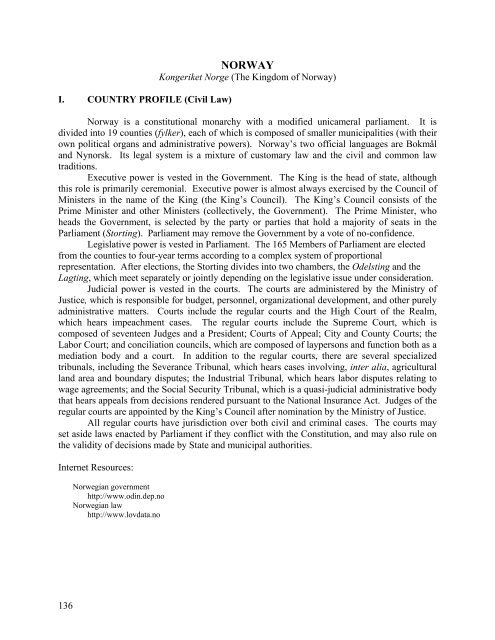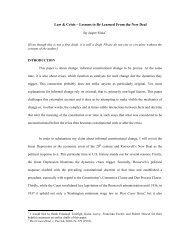Guide to Foreign and International Legal Citations - New York ...
Guide to Foreign and International Legal Citations - New York ...
Guide to Foreign and International Legal Citations - New York ...
Create successful ePaper yourself
Turn your PDF publications into a flip-book with our unique Google optimized e-Paper software.
I. COUNTRY PROFILE (Civil Law)<br />
136<br />
NORWAY<br />
Kongeriket Norge (The Kingdom of Norway)<br />
Norway is a constitutional monarchy with a modified unicameral parliament. It is<br />
divided in<strong>to</strong> 19 counties (fylker), each of which is composed of smaller municipalities (with their<br />
own political organs <strong>and</strong> administrative powers). Norway’s two official languages are Bokmål<br />
<strong>and</strong> Nynorsk. Its legal system is a mixture of cus<strong>to</strong>mary law <strong>and</strong> the civil <strong>and</strong> common law<br />
traditions.<br />
Executive power is vested in the Government. The King is the head of state, although<br />
this role is primarily ceremonial. Executive power is almost always exercised by the Council of<br />
Ministers in the name of the King (the King’s Council). The King’s Council consists of the<br />
Prime Minister <strong>and</strong> other Ministers (collectively, the Government). The Prime Minister, who<br />
heads the Government, is selected by the party or parties that hold a majority of seats in the<br />
Parliament (S<strong>to</strong>rting). Parliament may remove the Government by a vote of no-confidence.<br />
Legislative power is vested in Parliament. The 165 Members of Parliament are elected<br />
from the counties <strong>to</strong> four-year terms according <strong>to</strong> a complex system of proportional<br />
representation. After elections, the S<strong>to</strong>rting divides in<strong>to</strong> two chambers, the Odelsting <strong>and</strong> the<br />
Lagting, which meet separately or jointly depending on the legislative issue under consideration.<br />
Judicial power is vested in the courts. The courts are administered by the Ministry of<br />
Justice, which is responsible for budget, personnel, organizational development, <strong>and</strong> other purely<br />
administrative matters. Courts include the regular courts <strong>and</strong> the High Court of the Realm,<br />
which hears impeachment cases. The regular courts include the Supreme Court, which is<br />
composed of seventeen Judges <strong>and</strong> a President; Courts of Appeal; City <strong>and</strong> County Courts; the<br />
Labor Court; <strong>and</strong> conciliation councils, which are composed of laypersons <strong>and</strong> function both as a<br />
mediation body <strong>and</strong> a court. In addition <strong>to</strong> the regular courts, there are several specialized<br />
tribunals, including the Severance Tribunal, which hears cases involving, inter alia, agricultural<br />
l<strong>and</strong> area <strong>and</strong> boundary disputes; the Industrial Tribunal, which hears labor disputes relating <strong>to</strong><br />
wage agreements; <strong>and</strong> the Social Security Tribunal, which is a quasi-judicial administrative body<br />
that hears appeals from decisions rendered pursuant <strong>to</strong> the National Insurance Act. Judges of the<br />
regular courts are appointed by the King’s Council after nomination by the Ministry of Justice.<br />
All regular courts have jurisdiction over both civil <strong>and</strong> criminal cases. The courts may<br />
set aside laws enacted by Parliament if they conflict with the Constitution, <strong>and</strong> may also rule on<br />
the validity of decisions made by State <strong>and</strong> municipal authorities.<br />
Internet Resources:<br />
Norwegian government<br />
http://www.odin.dep.no<br />
Norwegian law<br />
http://www.lovdata.no
















